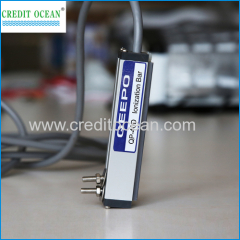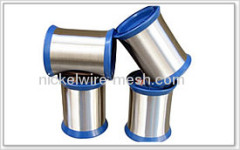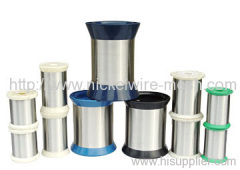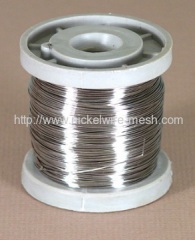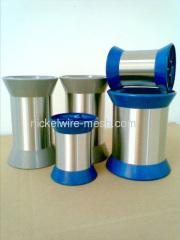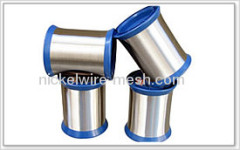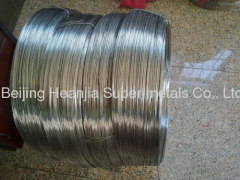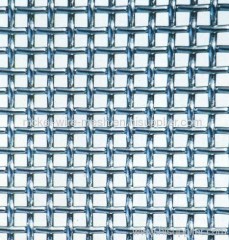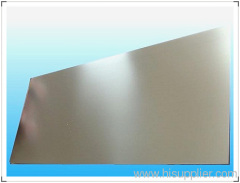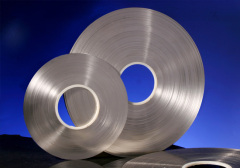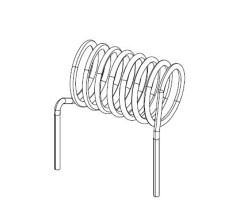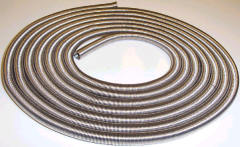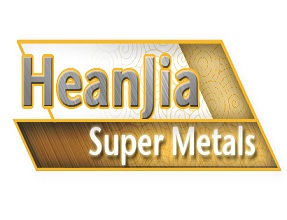
|
Heanjia Super-metals Co., Ltd.
|
Resistance wire
| Price: | 35.0~65.0 USD |
| Payment Terms: | T/T,L/C,D/A,D/P,WU |
| Place of Origin: | Hebei, China (Mainland) |
|
|
|
| Add to My Favorites | |
| HiSupplier Escrow |
Product Detail
Resistance wire: Nichrome Alloy:Ni80Cr20: the best material in the alloy serie.High melting point, High resistance to oxidation at high temperatures.
Nichrome Resistance Wire is corrosion resistant, and has a high melting point of about 1400 °C (2552 °F). It has relatively high resistivity and very good resistance to oxidation at high temperatures. The ultimate tensile strength of Nichrome Resistance Wireis 105,000 PSI (Pounds per Square Inch), yield strength is around 50,000 PSI, and modulus of elasticity is 31 x 106 PSI.
Nichrome Resistance Wire Applications:
Nichrome Resistance Wires have many advantages, such as deformation ability, thermal stability, mechanical character, shockproof ability in thermal state and anti-oxidization. For heating, Resistance Wire must be stable in air when hot. The wire forms a protective layer of chromium oxide. Due to its relatively high resistivity and resistance to oxidation at high temperatures,
Nichrome Resistance Wire is widely used in heating elements, electric furnace heating and heat-treating processes in the chemical, mechanical, metallurgical and defense industries, such as in hair dryers, electric ovens, toasters, vacuum coating, inner components of vacuum valves, etching resistor, brake resistor, tube heater, sealer, boiler and even electronic cigarettes.
Nichrome Resistance Wire is wound in coils to a certain electrical resistance, and current passed through to produce heat. They are also used as material of industrial equipment and electrical resistant elements in the electronics and light textile industries.
Nichrome Resistance Wire is an ideal material, because it has relatively high resistance and forms an adherent layer of chromium oxide when it is heated for the first time. Material beneath the Resistance Wire will not oxidize, preventing the Resistance Wire from breaking or burning out. So it is good for anti-corrosion and high resistant co-efficiency.
Nichrome Resistance Wire is applicable for heat treatment, air-carbon furnace, chemical industry, machinery, metallurgy. It is commonly used in ceramics as an internal support structure to help some elements of clay sculptures hold their shape while they are still soft.The Wire's metallurgical structure confers them a very good plasticity when cold. There is a growth of the grain under heat during utilization of the element without inducing embrittlement of it when cold.
Nichrome Resistance Wires are used for the manufacture of electric resistances for appliances (insulated elements type tubular resistances or for example opened elements on micanit plate) or for application of industrial furnaces. In addition of a relatively high specific resistance, Ni-Cr alloys join all the necessary properties for good performances in use of furnaces: Resistance to oxidation (they are not sensitive to aggressions of humid air). Low embrittlement at high temperature Good plasticity – Easier to give them a shape compared with Fe Cr Al (lower mechanical characteristics allow indeed a good control of elasticity of the product during shaping (coiling, folding, drawing). Good resistance to creeping (more important than ferritic alloys) which is important during conception of a resistance presenting big heights of waves. Maximal temperature recommended in the furnace: 1922 / 2012 °F in order to obtain a reasonable life time of the elements.
Available Specifications In Xinxing Nickel Wire Mesh Factory:
Wire Diameter: 0.05mm-10.0mm, 0.002 Inch to 0.3937 Inch
Nichrome Resistance Wire is widely used in heating elements, electric furnace heating and heat-treating processes in the chemical, mechanical, metallurgical and defense industries, such as in hair dryers, electric ovens, toasters, vacuum coating, inner components of vacuum valves, etching resistor, brake resistor, tube heater, sealer, boiler and even electronic cigarettes.
Nichrome Resistance Wire is wound in coils to a certain electrical resistance, and current passed through to produce heat. They are also used as material of industrial equipment and electrical resistant elements in the electronics and light textile industries.
Nichrome Resistance Wire is an ideal material, because it has relatively high resistance and forms an adherent layer of chromium oxide when it is heated for the first time. Material beneath the Resistance Wire will not oxidize, preventing the Resistance Wire from breaking or burning out. So it is good for anti-corrosion and high resistant co-efficiency.
Nichrome Resistance Wire is applicable for heat treatment, air-carbon furnace, chemical industry, machinery, metallurgy. It is commonly used in ceramics as an internal support structure to help some elements of clay sculptures hold their shape while they are still soft.The Wire's metallurgical structure confers them a very good plasticity when cold. There is a growth of the grain under heat during utilization of the element without inducing embrittlement of it when cold.
Nichrome Resistance Wires are used for the manufacture of electric resistances for appliances (insulated elements type tubular resistances or for example opened elements on micanit plate) or for application of industrial furnaces. In addition of a relatively high specific resistance, Ni-Cr alloys join all the necessary properties for good performances in use of furnaces: Resistance to oxidation (they are not sensitive to aggressions of humid air). Low embrittlement at high temperature Good plasticity – Easier to give them a shape compared with Fe Cr Al (lower mechanical characteristics allow indeed a good control of elasticity of the product during shaping (coiling, folding, drawing). Good resistance to creeping (more important than ferritic alloys) which is important during conception of a resistance presenting big heights of waves. Maximal temperature recommended in the furnace: 1922 / 2012 °F in order to obtain a reasonable life time of the elements.
Available Specifications In Xinxing Nickel Wire Mesh Factory:
Wire Diameter: 0.05mm-10.0mm, 0.002 Inch to 0.3937 Inch
The attached file is detailed description of other Nickel chromium alloy Resistance wire physical properties.
Ni20Cr80 Resistance Wire Properties: | ||
Material property | Value | Units |
Magnetic Attraction | None | |
Modulus ofelasticity | 2.2 × 1011 | Pa |
Specific gravity | 8.4 | None |
Density | 8400 | kg/m3 |
Melting point | 1400 | °C |
Electricalresistivity at room temperature | 1.0 × 10−6to 1.5 × 10−6 | Ωm |
Specific heat | 450 | Jkg−1°C−1 |
Thermalconductivity | 11.3 | Wm−1°C−1 |
Thermalexpansion (20oC to 100oC) | 14 × 10−6 | °C−1 |
Temperature Coefficient of Resistivity (25oCto 100oC) | 100 | ppm/oC |
Standardambient temperature and pressure used unless otherwise noted. | ||
Wire Further Processing | Cut to length Wire |
Flat Wire | |
Square and Shaped Wire | |
Rewinding and spooling | |
Polishing and cleaning |
The Service Part has more information about Wire Further Processing.
Didn't find what you're looking for?
Post Buying Lead or contact
HiSupplier Customer Service Center
for help!
Related Search
Nichrome Resistance Wire
Heat Resistance Wire
Stranded Resistance Wire
Heating Resistance Wire
Nichrome Wire Resistance
Annealing Resistance Wire
More>>


